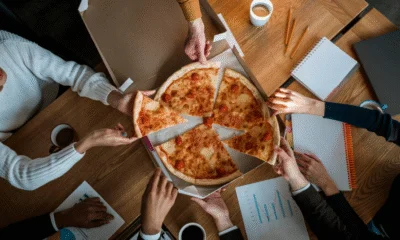The filing of Chapter 11 bankruptcy by a well-known pizza chain has become a recurring headline in the American business landscape. It’s a story that seems to play out every few years, a familiar drama of debt, disruption, and decline. From the fall of giants like Pizza Hut’s parent company, NPC International, to the struggles of regional favorites like Pie Five or Uno Pizzeria & Grill, the sight of a pizza chain seeking court protection prompts a mix of schadenfreude and genuine curiosity. How can an industry so central to the American culinary identity—a $46 billion behemoth built on dough, sauce, and cheese—be so perilous? The answer is not a single ingredient but a complex recipe where crushing financial leverage, an unforgivingly competitive battlefield, and profound shifts in consumer behavior combine to create a perfect storm.
The Weight of the Oven: Financial Structures and Private Equity
For many pizza chains that end up in Chapter 11, the journey begins not with a bad pizza, but with a burdensome balance sheet. The restaurant industry, with its predictable cash flows from daily sales, has long been a target for private equity firms and leveraged buyouts. The model is simple: acquire a company using a significant amount of borrowed money, with the target company’s own assets and cash flow used as collateral. The goal is to streamline operations, grow the brand, and eventually sell it or take it public for a substantial profit.
However, this debt-heavy strategy is a high-wire act. When it works, it can generate immense returns. But when external shocks occur—a recession, a pandemic, or a shift in consumer tastes—the weight of that debt becomes unbearable. The chain’s revenue, which should be invested in remodeling stores, launching marketing campaigns, or innovating the menu, is instead funneled directly into interest payments. This leaves the company starved for capital just when it needs it most.
The case of NPC International, the largest franchisee of both Pizza Hut and Wendy’s, is a textbook example. Loaded with over $900 million in debt, NPC was unable to invest in the crucial digital and delivery infrastructure needed to keep Pizza Hut competitive. While rivals like Domino’s pioneered frictionless ordering through their app and tracker, many Pizza Hut locations, especially those under NPC, felt dated. When the COVID-19 pandemic hit, the increased demand for delivery was a lifeline, but it also exposed the weaknesses of operators who couldn’t afford to adapt. NPC filed for Chapter 11 in 2020, burdened by debts it could no longer service. Chapter 11, in this context, becomes a tool for financial engineering—a chance to wipe the slate clean by persuading creditors to exchange debt for equity, effectively handing over ownership to lenders and freeing the operating business from its financial chains.
A Crowded Pie: The Brutality of the “Pizza Wars”
The financial pressures are exacerbated by the sheer ferocity of competition in what is often called the “Pizza Wars.” The American pizza market is arguably the most saturated segment in all of food service. It’s a multi-layered battlefield where chains must fight on every front:
The Value Front: This is the domain of the “Big Three”—Domino’s, Pizza Hut, and Papa John’s—along with regional players like Little Caesars with its iconic “Hot-N-Ready” model. Competition here is ruthless and primarily focused on price. The constant barrage of coupons, two-for-one deals, and $5.99 carry-out specials trains customers to be highly price-sensitive. Margins are razor-thin, and volume is everything. A chain that cannot achieve massive scale and operational efficiency will be bled dry in this war of attrition.
The Quality/Premium Front: Here, chains like MOD Pizza, Blaze Pizza, and &pizza have carved out a significant niche. They compete not on price but on the perception of higher quality, using artisanal terminology, fresh ingredients, and a customizable “fast-casual” experience. This model appeals to millennials and Gen Z consumers who prioritize transparency and customization over a cheap, predictable product. For traditional chains, this creates an “innovator’s dilemma”: do they risk alienating their value-focused core customer by moving upmarket, or do they cede the growing premium segment to these nimbler competitors?
The Local Front: Every town in America has its beloved local pizzeria. These establishments may not have the marketing budget of the national chains, but they compete effectively on quality, authenticity, and community connection. They often use their social media presence to create a loyal following that no national ad campaign can match.
The Non-Pizza Front: Perhaps the most significant threat comes from outside the category entirely. The rise of third-party delivery apps (3PDs) like DoorDash, Uber Eats, and Grubhub has fundamentally changed the game. These platforms have placed pizzerias in direct competition with every other restaurant on the app. When a customer opens DoorDash, the decision is no longer “which pizza should I order?” but “should I order pizza, sushi, a burger, or a salad?” This has dramatically raised the customer acquisition cost and diluted brand loyalty, forcing pizza chains to pay hefty commissions—often 15-30% per order—just to remain visible.
The Consumer Palate Shift: Beyond Pepperoni
Underlying the financial and competitive pressures is a fundamental evolution in what consumers want from their food. The traditional model of a greasy, heavy, inexpensive pizza delivered in 30 minutes or less is no longer the universal draw it once was.
Health and Wellness: While pizza will always be a treat, consumers are increasingly conscious of ingredients. There is growing demand for cleaner labels, plant-based options (like vegan cheese and meat alternatives), gluten-free crusts, and overall healthier profiles. Chains slow to adapt to these demands lose a segment of the market.
Digital Demands: Domino’s didn’t just become a pizza company; it became a tech company that sells pizza. The expectation for a seamless digital experience—from ordering via app or voice command to tracking the order in real-time—is now table stakes. Chains that have clunky websites, unreliable apps, or poor integration with delivery services appear outdated and inconvenient.
Experience over Transaction: The fast-casual model’s success is partly due to the “theater” of it. Customers, especially younger ones, enjoy watching their pizza be assembled and fired in an open kitchen. This creates an experience that a cardboard box delivered to your door cannot match.
Chapter 11 as a Strategic Pivot, Not Just a Failure
It’s crucial to understand that a Chapter 11 filing is not always a death knell. In fact, for many pizza chains, it is a strategic tool for survival and renewal. The process allows a company to do several critical things:
Restructure Debt: As mentioned, this is the primary function. It’s a chance to reduce the crushing debt load and emerge with a sustainable capital structure.
Reject Burdensome Leases: Pizza chains are often locked into long-term leases for poor locations. Chapter 11 allows them to “reject” these unprofitable leases, enabling a massive and rapid closure of underperforming stores to focus on profitable ones.
Pause Litigation: It provides a “automatic stay,” halting lawsuits from creditors, which gives the company breathing room to formulate a turnaround plan without being picked apart piecemeal.
Find a Buyer: Sometimes, Chapter 11 is used as a controlled process to sell the company. The court can facilitate an auction, often leading to a sale that maximizes value and potentially saves the brand, even if under new ownership.
The story of California Pizza Kitchen (CPK) is a recent example of Chapter 11 as a strategic reset. CPK filed in July 2020, weighed down by debt and the pandemic’s impact on its dine-in-heavy business. The process allowed it to shed debt, close unprofitable locations, and refocus its strategy on a smaller, stronger core of restaurants, with an enhanced emphasis on CPG (consumer packaged goods) sales of its frozen pizzas in grocery stores. It emerged from bankruptcy just a few months later as a leaner, more financially stable company.
The Future Slice: What Comes Next?
For pizza chains emerging from Chapter 11 or hoping to avoid it, the path forward requires a clear and focused strategy. The “one-size-fits-all” approach of the 1990s is obsolete. Success will depend on:
Defining a Niche: A chain can no longer be all things to all people. It must decide if it is a value leader (like Little Caesars), a tech-driven delivery expert (like Domino’s), or a quality-focused fast-casual brand (like MOD). Trying to straddle multiple categories dilutes the brand and confuses consumers.
Mastering the Unit Economics: The model of breakneck expansion is over. The future belongs to operators who can prove that a single store is highly profitable before even thinking about scaling. This means smarter real estate decisions, optimized menus, and labor models that work.
Owning the Customer Relationship: Relying solely on third-party delivery apps is a dangerous game. The most successful chains will be those who drive customers to their own channels—their app, website, or phone number—through loyalty programs and superior user experience, thereby avoiding the exorbitant commissions of the 3PDs.
The Chapter 11 filing of a pizza chain is more than a business failure; it is a stark symptom of an industry in the throes of a profound transformation. It represents the end of an era defined by debt-fueled expansion and generic mass-marketing. The future of pizza will be less about who has the most locations and more about who can most effectively adapt to a new reality defined by digital convenience, distinct value propositions, and financial discipline. In the end, the market is not just judging the quality of the crust or the richness of the sauce, but the soundness of the business model itself. The chains that survive will be those that learn to bake resilience into their recipe, right alongside the flour and yeast.

